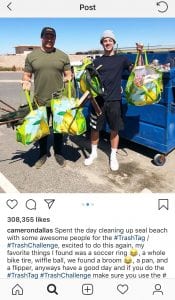Listen up, social media fanatics. There’s a challenge that’s been sweeping the internet recently that asks users to spread the goodness and clean up their environment! This trend known as the #TrashTag challenge isn’t exactly a new phenomenon either. If it sounds familiar, you are correct, and if you’ve never heard of it, you’ve stopped at the right place. Let’s dive into what the Trash Tag challenge is, why it matters, and how you can join the movement.
What is the Trash Tag Challenge?
The Trash Tag challenge began in 2015 by the outdoor gear company, UCO, in an effort to get people to care about the places in which they lived and become aware of the condition of the world around them. It didn’t really start to catch fire however, until this past March when a man from Arizona named Byron Román shared a picture of ecologist and activist Drici Tani Younes on Facebook. The picture featured Younes in a polluted area and then an after picture in that same area after he had cleaned it up. Román shared this post with a message that prompted apathetic young people to make a difference and do some good while they were at it. Since then, Román’s post has accumulated over more than 100,000 likes and 332,000 shares, growing by the day and helping people of all ages put down their phones and pick up a pair of gloves and a trash bag.
Byron Román’s share on Facebook
Why Is This Hashtag Important?
One of the many reasons that this hash tag matters is because it’s quite frankly refreshing. Unlike the many challenges that urge us to swallow whole spoonfuls of cinnamon or drink sprite and then eat bananas, this challenge harms no one in the process and offers all parties involved a more beneficial outcome. With the rate at which content moves across social media platforms and goes viral, it’s promising to see a message like this one gain momentum because it shows that many of us understand the dangers that wait for us if we continue to treat our environment the way we do. Because this hashtag also encourages us to go out in the world and help maintain our parks, beaches, and rivers, it also ensures we are physically removing some of the trash that litters our planet. With the rate that this trend is spreading at, it’s wonderful to see the change that comes from the power of social media.
But will this power be enough? The answer unfortunately is no. That doesn’t mean it’s time to flail our arms around in the air and boycott the trash tag challenge, but it does mean that we need to think more about the root cause of the plastic pollution epidemic. Although movements of this nature and efforts to recycle and reuse are not enough, they matter that much more when practiced in conjunction with tighter corporate and governmental practices. According to Mirjam Kopp, a global project leader on plastic pollution at Greenpeace, “The problem with plastics is not simply a litter problem, it is a pollution problem created by corporations and mismanaged by governments, and it should be treated as an inherently dangerous substance.” Who says we can’t start a new movement that encourages us to protest outside of these corporations that abuse their power and capture/share those moments on social media?
How You Can Get Involved
You know the drill! Find a nearby park, river, beach, or any area that needs cleaning, and take a picture of the area before you get to work. Clean the area, take a picture of it with you and your friends, and then post the final before and after pictures with the hashtag. Not only will you feel accomplished and satisified, but you never know who might see your post and feel compelled to try it too. All in all, movements like this do affect our environment and make a difference in our own lives, too. Share your best pictures with the Blue Velvet team and we will repost them here on our blog! Keep up the hard work Blue Velvets, and always remember the importance behind sharing the good in our world.
Instagram influencer and celebrity Cameron Dallas participating in the Trash Tag challenge


